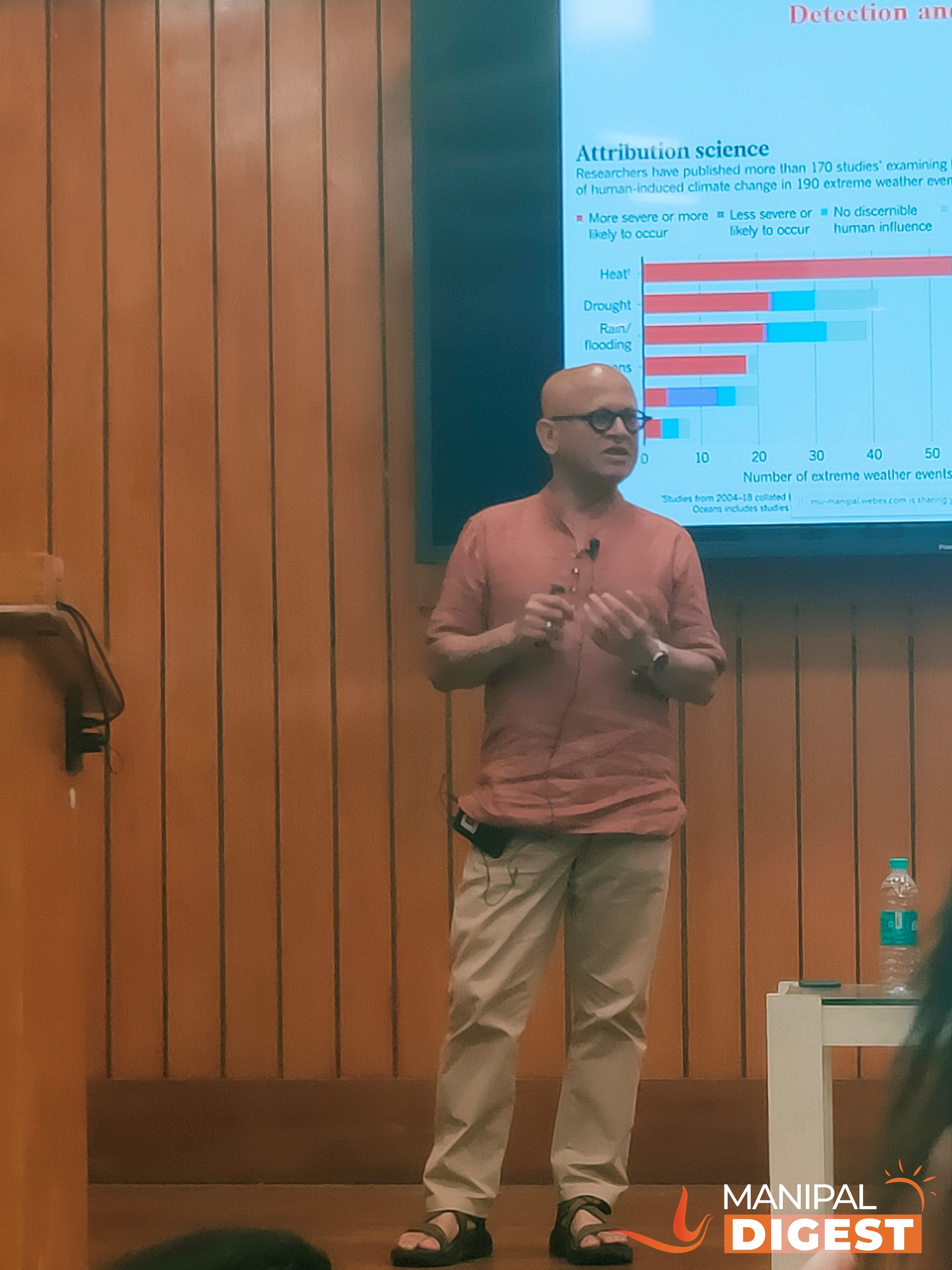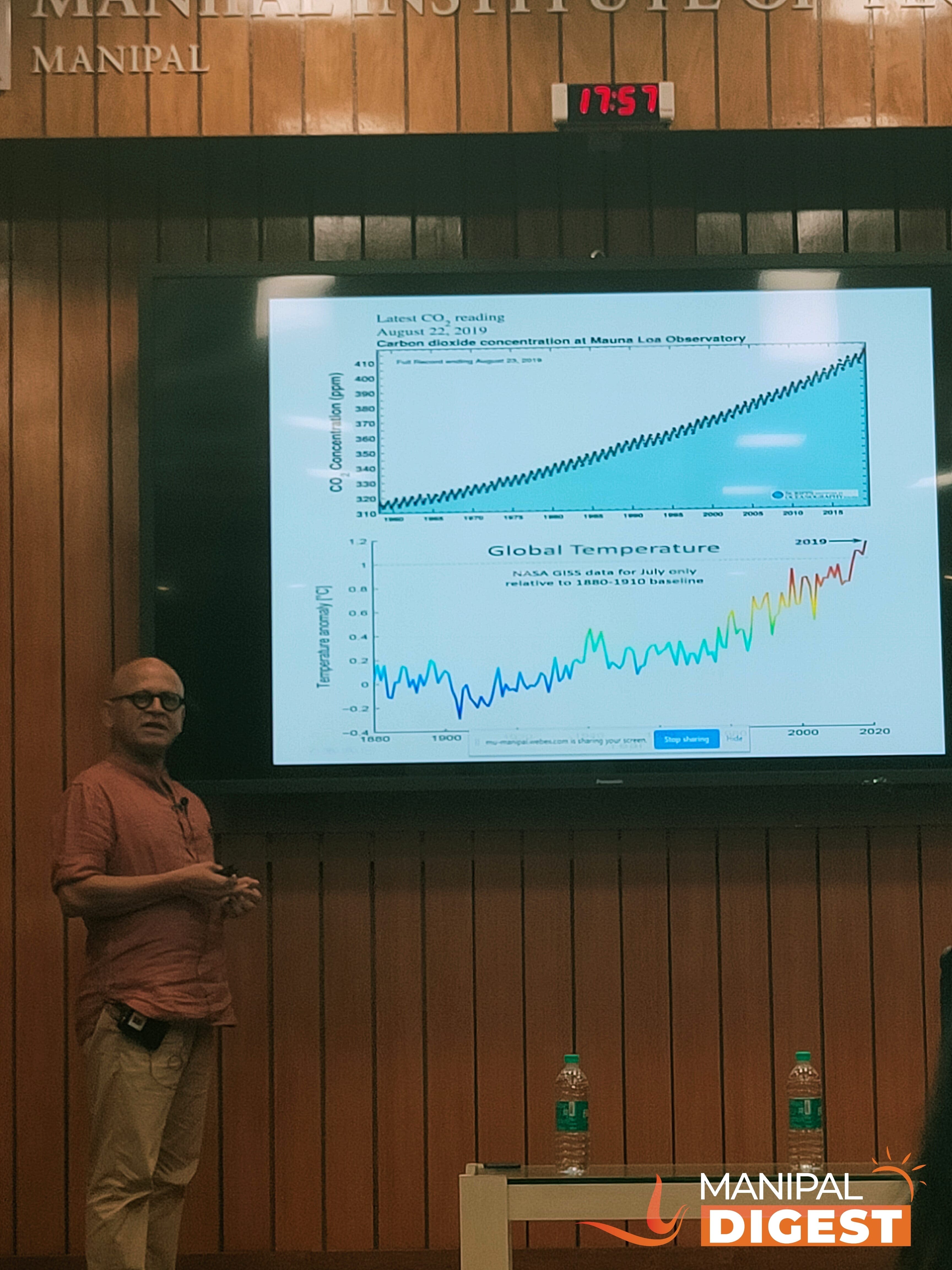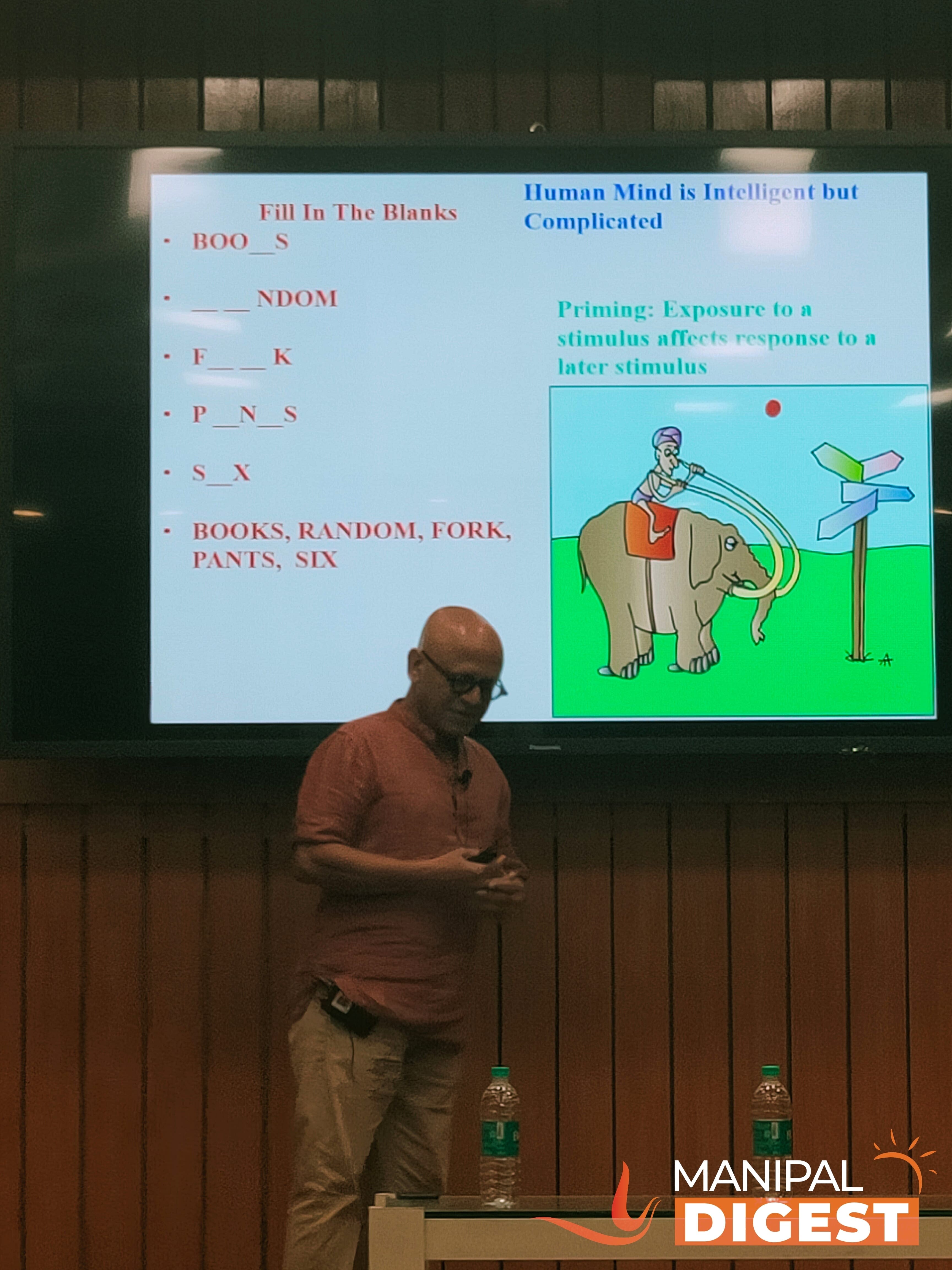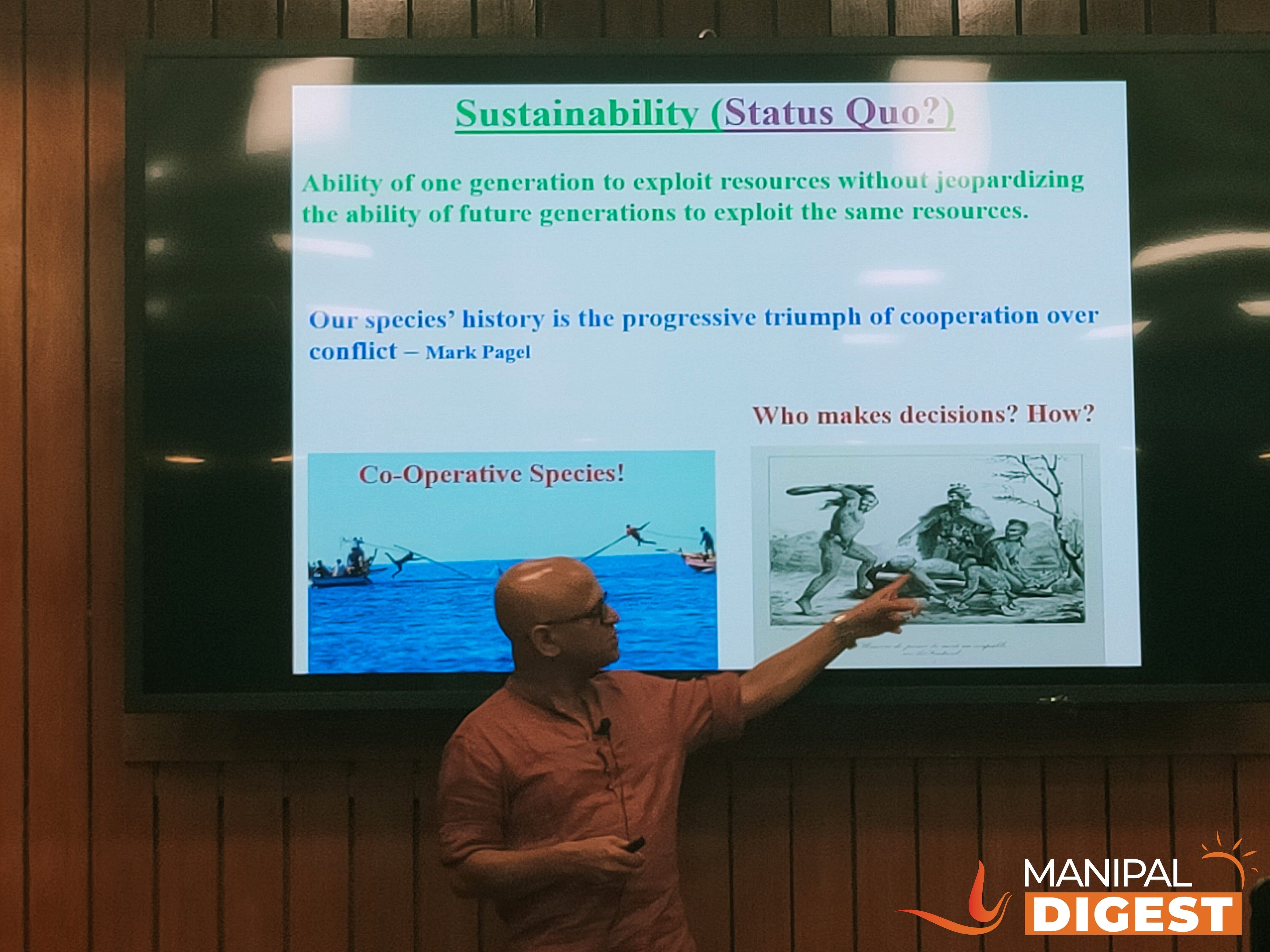
On 20th September at Sir M V Seminar Hall, Dr Raghu Murtugudde gave an academic talk about Cilmate Change, Sustainability and the Global Scenario. Sana Khanam from Manipal Digest paints the picture of what happened with both her pen and camera.
Dr Raghu Murtugudde:
Dr Raghu Murtugudde is a Professor of Atmospheric and Oceanic Science and Earth System Science at the University of Maryland. He is trained as an Engineer from IIT Bombay and Columbia University and has been working on numerical modelling of the Earth System. He is interested in human actions and reactions in the context of climate change and has extensively written about it.

Academic Talk
Highlighting the considerable increase in global warming and climate change, Dr Raghu Murtugudde delivered a special talk on “Climate Change, Sustainability and The Global Scenario” at Sir M V Seminar Hall, MIT under the Gandhian Centre for Philosophical Arts and Science of Manipal Academy of Higher Education at 5:30 pm on September 20, 2019.
Dr Raghu stated the phrase called BIG HISTORY which is coined by David Christian, a historian. His idea is if you want to know anything about humans you have to go back to Big Bang. Similarly, to understand human behaviour and biases we need to understand all the way from where life evolved or why we have become in way we are now. According to him Climate Change is a very scientific problem but he enlightened us from perspective of social, political and economic view. We are aware of why climate change is happening but it comes down to how we perceive the risk of climate change.
We are getting all our energy from the sun in parallel rays. More energy is received in the lower surface in per meter square than the higher altitude because of the curvature. Then there’s snow which reflects back the energy. The tropics are receiving more energy than they are emitting back. High latitudes are receiving less energy than they are emitting to the space. There is gradient. So, to balance out this gradient by circulating winds, cyclone ocean current. Before the industries revolution climate was changing due to orbital change. Now we are emitting a lot of greenhouse gasses because of which the earth’s surface is getting heated up. Global warming is to understand who we are? Why we are here? What we are doing?
The graph does not go uniformly due to the El Niño and ocean current. This has been used as in excuse by the companies to show that climate change has always existed. From 1918 each decade is getting is getting warmer. It represents the risk of earth getting warmer, water vaporization, sea ice has decreased, ocean temperature has increased, glacier is melting. Attribution means that the temperature change is related to increase in co2. Using various methods one can show up that temperature change is shown in heat waves, droughts, excessive rainfall. We need to show how global warming effects economy this is how politicians and companies will take serious steps towards it. He raised important questions like a place like Udupi which receives 3 cm rainfall suffers from water crisis. If Manipal got saviour rain its somewhere else’s rain drawn here. We need to think about how it will affect economy and agriculture.

Planet is not dying but the question is what will happen to us and how many species will we kill? Global warming is to understand who we are? Why we are here? What we are doing? Between climate and weather people get confused. For example, the in a place the cold is increasing so people think where is global warming but this is an affect. A psychologist Jonathan Hype proposed the idea of elephant and the rider analysis. We have something called the amalgam of brain which is an evolution of our experiences from fear and pain. He further explained it by the emotional elephant and the rational rider. If we want to human beings to respond to changes, we have to affect both the elephant and the rider. The elephant takes decisions which takes time to take decision has to respond now by the rational rider. Similarly, climate change is a future problem but we need to take decisions in the present.
Sustainability according to UN is the ability of one generation to exploit resources without compromising the ability of future generation to exploit resources. We have found the way to punish the people who exploit free rights. For example, in Hawaiian Islands if you are found consuming more than your share of fish you are punished. So, we need to internalize things and adopt norms that climate change is for real. Everything we do can affects the nature negatively

What can individuals do?
For example, the number of calories we consume by chicken, meat or any other dairy products and the amount of CO2 we emit by driving a Hybrid car whereas a vegetarian driving a SUV has much more bigger carbon footprint. People have to conscious for their each and every action. Every time we have shared resource tragedy of commons is very common. Whatever we do here pollutes the atmosphere as a global platform.
Dr Raghu mentioned about Mahatma Gandhi that somebody asked him what kind of system would you like to have in India to which he replied that it took half the resources of world to make Britain so think what would amount of resources will India take. He implied sustainability there. We have to think of economy as activity we are depended upon the people and environment. Kate Raworth has created something called doughnut economy which looks at ozone depletion, biodiversity loss, climate change, etc as something that has to be accounted for in every economics sector.

How do corporation act to these norms?
In Germany, Volkswagen was found cheating on its emission. They were caught just pricking the software on the car but the emission standards were not that good so they were penalized with huge amount of fine. Some reports say that those emissions would result to 1200 premature deaths in countries like Poland, France, etc.
Politicians they don’t solve problems they deal with problems. Barak Obama actually promised to reduce coal use in America but what he did was just exported these coals to India, China and Germany. So, the emission is not happening there but somewhere else. There was this tsunami and earthquake in Fukushima, Japan, which damaged the nuclear plant. Therefore, Japan switched from nuclear plant but it wasn’t necessary because of the tsunami. Since industrial revolution America and Europe are the biggest emitter of green house gases and India and China are growing to be emitters. The average emission of CO2 is 2 tons per person per year in India whereas in America its 22 tons per person per year. So, population has no relation with green house gas emission. High human development index to low economic index is the biggest challenge of today. Without destroying ecology, development is what to be achieved.
So, he gave one solution that is: solar roadways. These are made solar panels which generate electricity that in turn generates revenue. Its clean energy so everybody can drive an electric car without actually emitting pollution and no carbon footprint. For those in the north the panels use energy to collect the power elements to keep the surface temperature a few degrees above freezing heated. So, no more ice coming in the way of your drive, no more wasting tax money on snow removal, etc. Every town will have their own solar panels which can be programmed into traffic signals, parking lots. These panels are also pressure sensors so they can detect when larger objects like trees have fallen and can signal the driver to slow down. These roadways use recycled products in formation. Solar roadways technology was invented by engineer couple Julie Brusaw and Scott in 2006.
He concluded his talk by a discussion on question and answer by the audience.

Very informative